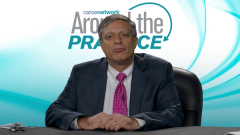
What is the Role of CAR T-Cell Therapy in R/R MM?
Expert perspectives on the advent of CAR T-cell therapy in relapsed/refractory multiple myeloma, and how its role may integrate with bispecific antibody therapy.
Episodes in this series

Transcript:
Sagar Lonial, MD: You went down the CAR [chimeric antigen receptor] T-cell road. What did we hear about CAR T?
Sandy Wong, MD: Where do I start? Several things were presented about CAR T [at American Society of Hematology Annual Meeting]. The data for 1 cohort for the KarMMa-2 study were presented by Dr [Krina] Patel. They gave ida-cel [idecabtagene vicleucel] to patients who were functionally high risk. If you look at the results, the overall response rate was in the 80th percentile, and the PFS [progression-free survival] was around 11 months. When I looked at the data, I expected a little better than that. This was earlier in lines of therapy, as opposed to patients who had no other options in the 4-plus lines.
We also saw a dual BCMA- and CD19-directed CAR [T-cell therapy]. I had to write down the name: GCO12F. What was exciting about this 1 was that the overall response rate was 100%. After that, the CR [complete response] rate was very low grade. They didn’t have any ICANS [immune-effector cell-associated neurotoxicity syndrome] events. They also didn’t have any high-grade infections either, so that was exciting. Last but certainly not least was GPRC5D-targeted CAR T cells. We saw the New England Journal of Medicine paper about this CAR-T in the MSKCC [Memorial Sloan Kettering Cancer Center] single-institution study. In that study, they escalated [the dose] all the way up to 450 [x 106]. They did see 2 cases of cellular toxicity, which was a bit unexpected.
In a different study, a multi-institution study, there were some changes in terms of the manufacturing, but it’s in the same binder. The overall response rate was comparable with the paper; it was 70% to 80%. In terms of adverse effects, there was dysgeusia and cytopenia, as expected. Those were also similar to the data. The thing we’re all waiting to see is in this study they when they escalate to the 450 [x 106] dose level. I’ll be very interested to see what toxicities they have when they escalate. In terms of the escalation, the last dose level they reported on was 350 [x 106], and there weren’t any ... toxicities at that point. These are really exciting data. This CAR—considering the target—is going to be able to meet that unmet need, which is those who’ve had BCMA exposure.
Sagar Lonial, MD: The question we’re all going to get is, let’s say you’ve got 2 therapies that can go after whatever target you want: a CAR or a T-cell engager. For the sake of discussion, let’s not anticipate belimumab coming back. Those are your 2 choices right now. What are you going to do?
Samuel M. Rubinstein, MD: Assuming I can do both?
Sagar Lonial, MD: That’s a good caveat. Access to CAR is a challenge.
Samuel M. Rubinstein, MD: Assuming I can do both and assuming a patient can feasibly be bridged to CAR T, I’d sequence CAR before a bispecific in most cases. We have better data about bispecifics as a viable salvage option post-CAR than we do the other way around.
Caitlin Costello, MD: This is going to vary. This is going to be a case-by-case basis. All things being equal, if I have a slot and the manufacturing time is reasonable, CAR T is an attractive option for patients to have a treatment-free interval. If there’s 1 unmet need in multiple myeloma, it’s how do we stop therapy for patients? CAR T offers that as an attractive option. But we have functional high-risk patients, those with ... and aggressive myeloma, who just can’t wait. We’re all going to start reaching for off-the-shelf options so we can have more immediate interventions.
Timothy Schmidt, MD: I agree 100%. For patients who can wait and have access to CAR T, that’s my go-to. There are a lot of those patients. As we get into later lines of relapse and as they’ve been exposed to all these different drugs attacking plasma cell biology, it starts to get more aggressive. In these later-line relapses, if we have that off-the-shelf option for our patients, maybe we have go to it in some of these instances. They’re both great options. It’s not necessarily wrong, but I agree that I’d typically go for the CAR first.
Caitlin Costello, MD: Unless there’s more of those fast CARs, like the 1 you were mentioning with 100%. That was in the up-front setting, but they have a 3-day manufacturing time. If we can figure out how some of these manufacturing mechanisms can be improved, maybe the level is even at that point.
Samuel M. Rubinstein, MD: Or if there’s an allogenic approach someday that’s viable. Not yet.
Timothy Schmidt, MD: With the KarMMa-2 cohort that you presented with functional high-risk patients, we were all hoping for a little better. A great therapy would help overcome some of this high risk. These are also the patients who are the highest risk. Compared with the initial cohort—the majority of patients were able to wait for CAR T manufacturing and things like that—unfortunately, these are patients who are unlikely to have quite as good responses with anything we’ve got that’s available. We choose the best thing that we have at that point in time. As we start to explore this earlier on, that’s when it’s most sensitive and when we should be trying to move these things forward in the future. Right now, in the late-relapse setting, I’m glad we’ve got access to all of it.
Transcript edited for clarity.
Newsletter
Stay up to date on recent advances in the multidisciplinary approach to cancer.



















































































